Sterling Hayden
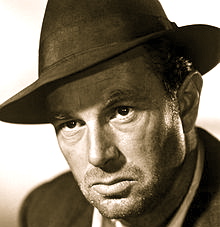
Top Gun (1955) Full Western
Elenco: Sterling Hayden; William Bishop; Karin Booth; James Millican; Regis Toomey; Hughf Sanders; John Dehner. Dirigido por Ray Nazarro.
 In The Asphalt Jungle (1950)
In The Asphalt Jungle (1950)
Sterling Walter Hayden (born Sterling Relyea Walter; March 26, 1916 – May 23, 1986) was an American actor and author. For most of his career as a leading man, he specialized in westerns and film noir, such as Johnny Guitar,The Asphalt Jungle and The Killing. Later on he became noted as a character actor for such roles as Gen. Jack D. Ripper in Dr. Strangelove or: How I Learned to Stop Worrying and Love the Bomb (1964). He also played the Irish-American policeman, Captain McCluskey, in Francis Ford Coppola‘s The Godfather in 1972, and the novelist Roger Wade in 1973’s The Long Goodbye. He played the role of Leo Dalcò in Bernardo Bertolucci‘s 1900 in 1976. At six feet five inches (196 cm), he was taller than most actors.
Biography – Early Life, Education
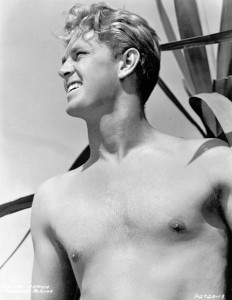 He was born in Montclair, New Jersey, to George and Frances Walter, who named him Sterling Relyea Walter. After his father died, he was adopted at the age of nine by James Hayden and renamed Sterling Walter Hayden. He grew up in coastal towns of New England, and as a child lived in New Hampshire, Massachusetts, Pennsylvania, Washington, D.C., and Maine, where he attended Wassookeag School in Dexter, Maine.
He was born in Montclair, New Jersey, to George and Frances Walter, who named him Sterling Relyea Walter. After his father died, he was adopted at the age of nine by James Hayden and renamed Sterling Walter Hayden. He grew up in coastal towns of New England, and as a child lived in New Hampshire, Massachusetts, Pennsylvania, Washington, D.C., and Maine, where he attended Wassookeag School in Dexter, Maine.
Hayden was a genuine adventurer and man of action, not dissimilar from many of his movie parts. He dropped out of high school at the age of 16 and took a job as mate on a schooner. His first voyage was to Newport Beach, California from New London, Connecticut. Later, he was a fisherman on the Grand Banks of Newfoundland, ran a charter yacht, and served as a fireman on eleven trips to Cuba aboard a steamer. He skippered a trading schooner in the Caribbean after earning his master’s license, and in 1937 he served as mate on a world cruise of the schooner Yankee. After serving as sailor and fireman on larger vessels and sailing around the world several times, he was awarded his first command aged 22, skippering the square rigger Florence C. Robinson 7,700 miles from Gloucester, Massachusetts, to Tahiti in 1938.
Hollywood Years and Military Service
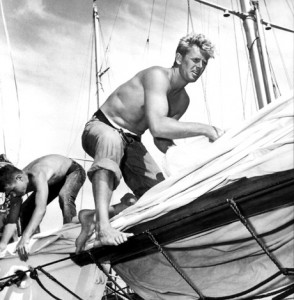 Hayden became a print model and later signed a contract with Paramount Pictures, who dubbed the 6′ 5″ (1.96 m) actor “The Most Beautiful Man in the Movies” and “The Beautiful Blond Viking God”. His first film, Virginia (1941), starred Madeleine Carroll, with whom he fell in love and married.
Hayden became a print model and later signed a contract with Paramount Pictures, who dubbed the 6′ 5″ (1.96 m) actor “The Most Beautiful Man in the Movies” and “The Beautiful Blond Viking God”. His first film, Virginia (1941), starred Madeleine Carroll, with whom he fell in love and married.
After two film roles, he left Hollywood and joined the United States Marine Corps as a private, under the name “John Hamilton” (a pseudonym Hayden only used in the military). While at Parris Island he was recommended for Officer Candidate School. After graduation, he was commissioned a second lieutenant and was transferred to service as an undercover agent with William J. Donovan‘s COI office. He remained there after it became the OSS.
As OSS agent John Hamilton, his World War II service included sailing with supplies from Italy to Yugoslav partisans and parachuting into fascist Croatia. Hayden, who also participated in the Naples-Foggia campaign and established air crew rescue teams in enemy-occupied territory, became a first lieutenant on September 13, 1944, and a captain on February 14, 1945. He received the Silver Star (for gallantry in action in the Balkans and Mediterranean; “Lt. Hamilton displayed great courage in making hazardous sea voyages in enemy-infested waters and reconnaissance through enemy-held areas”), a Bronze Arrowhead device for parachuting behind enemy lines, and a commendation from Yugoslavia’s Marshal Tito. He left active duty on December 24, 1945.
His great admiration for the bravery of the Communist partisans led to a brief membership in the Communist Party. He was apparently active in supporting an effort by the Communist-controlled motion picture painters’ union to absorb other film industry unions. As the Red Scare deepened in U.S., he cooperated with the House Un-American Activities Committee, confessing his brief Communist ties and “naming names.” His wife at that time, Betty de Noon, insisted that the ‘names’ her ex-husband provided were already in the hands of the Committee, which had a copy of the Communist Party’s membership list. In any event, Hayden subsequently repudiated his cooperation with the Committee, stating in his autobiography “I don’t think you have the foggiest notion of the contempt I have had for myself since the day I did that thing.”
Personal Life
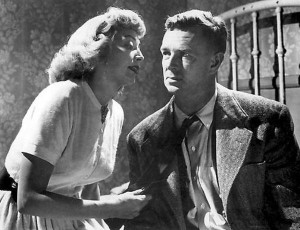 Sterling Hayden often professed distaste for film acting, claiming he did it mainly to pay for his ships and voyages. In 1958, after a bitter divorce, he was awarded custody of his children. He defied a court order and sailed to Tahiti with all four children, Christian, Dana, Gretchen and Matthew. The crew sailed from San Francisco Bay to Tahiti, where Hayden had planned to film a movie. Hayden also invited well known photographer Dody Weston Thompson along to document the trip and to help shoot location choices. Her South Seas folio is replete with fascinating photographs of the Hayden’s ship The Wanderer, on-deck photos of life aboard the ship, colorful prints of his children, Tahitian women and children, and of unique artifacts on shore. The film did not materialize, however, and according to Dody’s notes U.S. Camera printed these photographs of paradise in 1961.
Sterling Hayden often professed distaste for film acting, claiming he did it mainly to pay for his ships and voyages. In 1958, after a bitter divorce, he was awarded custody of his children. He defied a court order and sailed to Tahiti with all four children, Christian, Dana, Gretchen and Matthew. The crew sailed from San Francisco Bay to Tahiti, where Hayden had planned to film a movie. Hayden also invited well known photographer Dody Weston Thompson along to document the trip and to help shoot location choices. Her South Seas folio is replete with fascinating photographs of the Hayden’s ship The Wanderer, on-deck photos of life aboard the ship, colorful prints of his children, Tahitian women and children, and of unique artifacts on shore. The film did not materialize, however, and according to Dody’s notes U.S. Camera printed these photographs of paradise in 1961.
Marin County Superior Court Judge Harold Haley would later order Hayden to repay Republic Pictures, who financed the trip with two promissory notes, nearly $50,000 for defaulting on an agreement to repay the debt. In 1960, he married Catherine Devine McConnell. They had two sons, Andrew and David, and were married until his death in 1986. McConnell also had a son from her first marriage, to journalist Scott McConnell.
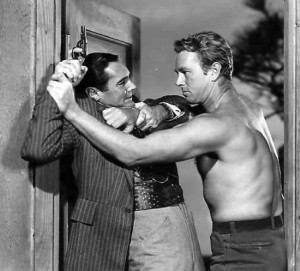 In the early 1960’s, Hayden rented one of the pilot houses of the retired ferryboat Berkeley, docked in Sausalito, California where he resided while writing his autobiography Wanderer, which was first published in 1963. In it, he reminisces about turning points in his life:
In the early 1960’s, Hayden rented one of the pilot houses of the retired ferryboat Berkeley, docked in Sausalito, California where he resided while writing his autobiography Wanderer, which was first published in 1963. In it, he reminisces about turning points in his life:
- “The sun beats down and you pace, you pace and you pace. Your mind flies free and you see yourself as an actor, condemned to a treadmill wherein men and women conspire to breathe life into a screenplay that allegedly depicts life as it was in the old wild West. You see yourself coming awake any one of a thousand mornings between the spring of 1954, and that of 1958 ‑ alone in a double bed in a big white house deep in suburban Sherman Oaks, not far from Hollywood. “The windows are open wide, and beyond these is the backyard swimming pool inert and green, within a picket fence. You turn and gaze at a pair of desks not far from the double bed. This is your private office, the place that shelters your fondest hopes: these desks so neat, patiently waiting for the day that never comes, the day you’ll sit down at last and begin to write.”
- “Why did you never write? Why, instead, did you grovel along, through the endless months and years, as a motion‑picture actor? What held you to it, to something you so vehemently professed to despise? Could it be that you secretly liked it—that the big dough and the big house and the high life meant more than the aura you spun for those around you to see?
- Hayden’s wild,’ they said. ‘He’s kind of nuts‑but you’ve got to hand it to him. He doesn’t give a damn about the loot or the stardom or things like that—something to do with his seafaring, or maybe what he went through in the war . . .'”
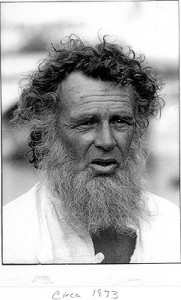 In the 1970’s, after his appearance in The Godfather, he appeared several times on NBC’s Tomorrow Show with Tom Snyder, where he talked about his career resurgence and how it had funded his travels and adventures around the world. Hayden bought a canal barge in the Netherlands in 1969, eventually moving it to the heart of Paris and living on it part of the time. He also shared a home in Wilton, Connecticut with his family and had an apartment in Sausalito.
In the 1970’s, after his appearance in The Godfather, he appeared several times on NBC’s Tomorrow Show with Tom Snyder, where he talked about his career resurgence and how it had funded his travels and adventures around the world. Hayden bought a canal barge in the Netherlands in 1969, eventually moving it to the heart of Paris and living on it part of the time. He also shared a home in Wilton, Connecticut with his family and had an apartment in Sausalito.
Hayden wrote two acclaimed books: an autobiography, Wanderer (1962), and a novel Voyage (1976).
Sterling Hayden died of prostate cancer in Sausalito in 1986, age 70.

